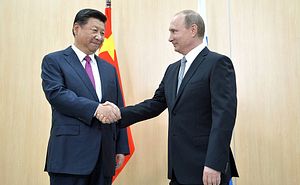Announced in 2013 on a stage at Nazarbayev University in Astana, Kazakhstan by Chinese President Xi Jinping, the land-based portion of the “One Belt, One Road” initiative (the Silk Road Economic Belt) traces a line through Central Asia. The Chinese are far from the first to brand cross-regional trade visions under the Silk Road banner — although, as several speakers at a recent workshop hosted by George Washington University’s Central Asia Program stressed, the Chinese are the first to put serious money behind their efforts.
Alexander Cooley of Columbia University’s Harriman Institute contrasted the OBOR project with the sometimes-discussed, but more often dismissed, U.S. vision of a New Silk Road. The Chinese, Cooley said, are “actually committing hundreds of billions of dollars, the U.S… not much, if any.” Further, the Chinese have established several funding vehicles to support new infrastructure developments–from the Silk Road Fund to the Asian Infrastructure Investment Bank (AIIB).
Most importantly, perhaps, the Chinese initiative signals China’s rise and a commitment to lasting future engagement with the region. Meanwhile, Cooley said, the “New Silk Road for the U.S. is associated with a legacy of regional withdrawal.” Another speaker, Scott Smith of the U.S. Institute of Peace, was just as critical of the New Silk Road policy, saying that it “is a vision that sometimes masquerades as a policy.”
Russia’s own form of economic engagement in the region–in the guise of the Eurasian Economic Union–had a rocky first year, as Alex Nice noted in an article for The Diplomat Magazine in January. Despite the fact that Russian President Vladimir Putin and Xi have broached the idea of linking their two economic endeavors together, experts doubt the feasibility of hooking the EEU to the OBOR’s better-funded wagon. Cooley said the two were “conceptually incompatible”: the EEU is an effort to fence-in economic activity within a regional block whereas the OBOR is about connectivity between regions (Asia and Europe).
Meanwhile, Russia’s ability to make good on economic commitments in the region is increasingly in doubt (just ask Kyrgyzstan). At the same time, as RUSI’s Sarah Lain commented, Moscow’s economic leverage on the region is waning, to an extent, as the value of remittances drop and some migrant workers return home.
Even a slowing China presents a more reliable investor that Russia, not just because its economy is growing (whereas Russia’s has contracted), but because the OBOR is a necessary part of Beijing’s strategy to deal with the domestic ramifications of slowing growth.
“In many ways, from the Chinese perspective this [OBOR] is part of the answer to the domestic slowdown,” Rafaello Pantucci of RUSI said. While domestic demand slackens, Central Asia’s infrastructure gap remains massive. China’s steel mills can continue apace as long as bridges and roads and railways need building in Central Asia.
This, of course, has not stopped Kazakh President Nursultan Nazarbayev from pointing to both the Russian recession and China’s slowdown as factors in Kazakhstan’s own economic stagnation. This is as much a tactic for Nazarbayev to displace blame as it is the truth. Kazakhstan’s economic woes are inextricable from those of Russia, but Astana is not entirely innocent.
While it may be exciting for geopolitical wonks to float the idea of a great power contest between Russia and China, with Central Asia as the setting, many experts dismiss this formulation outright or at the very least push the horizon to the extreme long-term realm. Russia, China, and the Central Asian states themselves share a fundamental idea of what stability in the region looks like and how to maintain it. Overarching shared interests among them virtually ensure that areas of friction will be managed rather than allowed to spark.
“Chinese commentators are not naive about the problems that may arise,” Nadège Rolland of the National Bureau of Asian Research said. “They see some potential problems in terms of power contest but they don’t see Russia as being a problem. They see the U.S. as being a problem.”

































